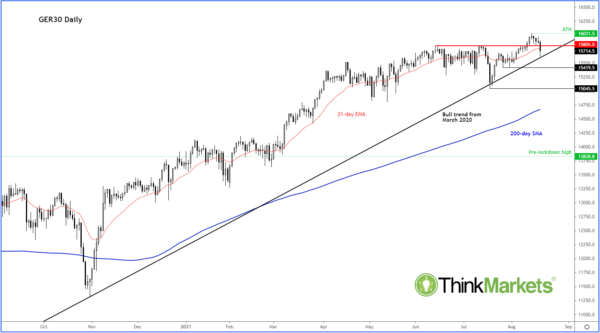The markets are throwing a mini taper tantrum. The key question is whether the latest dip will be bought or are we going to witness a proper sell-off? Well, so far it too early to tell, and until proven otherwise I would give the bulls the benefit of the doubt.
European stocks and US index futures extended their falls during the European morning session, while the dollar strengthened further against all major currencies except safe-havens Japanese yen and Swiss franc. Gold was caught between two major forces, with the impact of stronger dollar being offset by haven demand and slightly weaker European bond yields. Crude oil slumped and copper prices weakened further.
So, what’s going on?
Well, it looks like the market is responding two to major bearish catalysts. As you may recall from my note yesterday, commodities were already getting crushed on concerns the recovery was slowing down in both the US and China (the world’s largest economies), after a handful of disappointing macro numbers. Adding to those worries were uncertainty over Covid, as well as concerns over valuations and inflation. Then, investors were reminded about tapering after the FOMC’s last meeting minutes revealed Fed officials agreed they could start slowing the pace of bond purchases later this year.
Will the dip be bought again?
So, sentiment is cautious as we head towards mid-day. But remember that previous weakness for indices have repeatedly been bought. While this time it could be different, it is worth remembering a few things. First, the European Central Bank and a few others are in no rush to slow their stimulus measures. Second, even if the Fed tapers bond purchases, it will still have a very loose policy compared to pre-Covid. Third, the Fed has already prepared the market for tapering and so the FOMC’s meeting minutes revealed nothing we didn’t know already.
Indeed, as the ECB is likely to remain dovish for longer. Among other things, this should keep the pressure on the euro, which in turn should help Eurozone exports and boost the appeal of European equities on a relative basis. Obviously, there is a risk that a Chinese-led slowdown could hurt demand for European exports, while the US recovery may have peaked. Although data from both regions have been disappointing of late, a few misses here and there should be expected as the road to recovery was always going to be a bumpy one. Some softness in data should not trouble investors too much unless it becomes a trend. So far, we have only seen a handful of disappointing macro pointers. Let’s not jump to any conclusions.
DAX testing trend line
“Buying the dip” remains a favourite stock market strategy for many as it has consistently worked. Well, the DAX was testing a key support area around its rising trend line circa 15600-15700. Let’s see if the bulls will emerge here, or whether the selling pressure will cause a break down.














